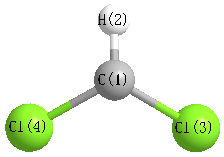Jump to
S1C2
Energy calculated at MP2=FULL/aug-cc-pVTZ
| | hartrees |
|---|
| Energy at 0K | -958.068597 |
| Energy at 298.15K | |
| HF Energy | -957.448985 |
| Nuclear repulsion energy | 127.089778 |
The energy at 298.15K was derived from the energy at 0K
and an integrated heat capacity that used the calculated vibrational frequencies.
Vibrational Frequencies calculated at MP2=FULL/aug-cc-pVTZ
| Mode Number |
Symmetry |
Frequency
(cm-1) |
Scaled Frequency
(cm-1) |
IR Intensities
(km mol-1) |
Raman Act
(Å4/u) |
Dep P |
Dep U |
|---|
| 1 |
A1 |
3366 |
3202 |
1.55 |
|
|
|
| 2 |
A1 |
784 |
746 |
6.33 |
|
|
|
| 3 |
A1 |
317 |
302 |
0.32 |
|
|
|
| 4 |
B1 |
394i |
375i |
36.34 |
|
|
|
| 5 |
B2 |
1258 |
1196 |
53.80 |
|
|
|
| 6 |
B2 |
969 |
922 |
136.48 |
|
|
|
Unscaled Zero Point Vibrational Energy (zpe) 3149.1 cm
-1
Scaled (by 0.9514) Zero Point Vibrational Energy (zpe) 2996.1 cm
-1
See section
III.C.1 List or set vibrational scaling factors
to change the scale factors used here.
See section
III.C.2
Calculate a vibrational scaling factor for a given set of molecules
to determine the least squares best scaling factor.
Geometric Data calculated at MP2=FULL/aug-cc-pVTZ
Point Group is C2v
Cartesians (Å)
| Atom |
x (Å) |
y (Å) |
z (Å) |
|---|
| C1 |
0.000 |
0.000 |
0.668 |
| H2 |
0.000 |
0.000 |
1.733 |
| Cl3 |
0.000 |
1.459 |
-0.169 |
| Cl4 |
0.000 |
-1.459 |
-0.169 |
Atom - Atom Distances (Å)
| |
C1 |
H2 |
Cl3 |
Cl4 |
| C1 | | 1.0652 | 1.6818 | 1.6818 |
H2 | 1.0652 | | 2.3971 | 2.3971 | Cl3 | 1.6818 | 2.3971 | | 2.9177 | Cl4 | 1.6818 | 2.3971 | 2.9177 | |
 More geometry information
More geometry information
Calculated Bond Angles
| atom1 |
atom2 |
atom3 |
angle |
|
atom1 |
atom2 |
atom3 |
angle |
| Cl3 |
C1 |
H2 |
119.837 |
|
Cl3 |
C1 |
Cl4 |
120.325 |
| Cl4 |
C1 |
H2 |
119.837 |
|
Electronic energy levels
Charges, Dipole, Quadrupole and Polarizability
Jump to
S1C1
Energy calculated at MP2=FULL/aug-cc-pVTZ
| | hartrees |
|---|
| Energy at 0K | -958.069467 |
| Energy at 298.15K | -958.070315 |
| HF Energy | -957.450636 |
| Nuclear repulsion energy | 126.881690 |
The energy at 298.15K was derived from the energy at 0K
and an integrated heat capacity that used the calculated vibrational frequencies.
Vibrational Frequencies calculated at MP2=FULL/aug-cc-pVTZ
| Mode Number |
Symmetry |
Frequency
(cm-1) |
Scaled Frequency
(cm-1) |
IR Intensities
(km mol-1) |
Raman Act
(Å4/u) |
Dep P |
Dep U |
|---|
| 1 |
A' |
3318 |
3157 |
0.74 |
|
|
|
| 2 |
A' |
791 |
753 |
11.35 |
|
|
|
| 3 |
A' |
509 |
484 |
20.59 |
|
|
|
| 4 |
A' |
311 |
296 |
0.44 |
|
|
|
| 5 |
A" |
1265 |
1204 |
44.18 |
|
|
|
| 6 |
A" |
936 |
890 |
158.81 |
|
|
|
Unscaled Zero Point Vibrational Energy (zpe) 3564.9 cm
-1
Scaled (by 0.9514) Zero Point Vibrational Energy (zpe) 3391.6 cm
-1
See section
III.C.1 List or set vibrational scaling factors
to change the scale factors used here.
See section
III.C.2
Calculate a vibrational scaling factor for a given set of molecules
to determine the least squares best scaling factor.
Geometric Data calculated at MP2=FULL/aug-cc-pVTZ
Point Group is Cs
Cartesians (Å)
| Atom |
x (Å) |
y (Å) |
z (Å) |
|---|
| C1 |
0.012 |
0.692 |
0.000 |
| H2 |
-0.471 |
1.646 |
0.000 |
| Cl3 |
0.012 |
-0.171 |
1.456 |
| Cl4 |
0.012 |
-0.171 |
-1.456 |
Atom - Atom Distances (Å)
| |
C1 |
H2 |
Cl3 |
Cl4 |
| C1 | | 1.0691 | 1.6919 | 1.6919 |
H2 | 1.0691 | | 2.3770 | 2.3770 | Cl3 | 1.6919 | 2.3770 | | 2.9110 | Cl4 | 1.6919 | 2.3770 | 2.9110 | |
 More geometry information
More geometry information
Calculated Bond Angles
| atom1 |
atom2 |
atom3 |
angle |
|
atom1 |
atom2 |
atom3 |
angle |
| Cl3 |
C1 |
H2 |
117.048 |
|
Cl3 |
C1 |
Cl4 |
118.702 |
| Cl4 |
C1 |
H2 |
117.048 |
|
Electronic energy levels
Charges, Dipole, Quadrupole and Polarizability
